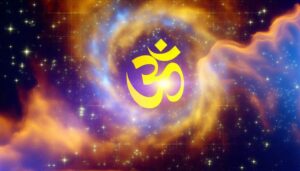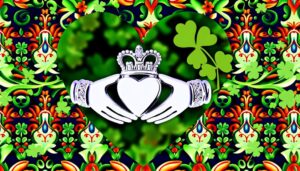Understanding the Eye of Ra: Its Symbol and Meaning
The Eye of Ra, a cornerstone of ancient Egyptian mythology, symbolizes protection, royal authority, and divine retribution. Represented as a sun disk encircled by a cobra, it embodies the omnipotence and vigilant gaze of the sun god Ra.
This powerful emblem underscores cosmic order and the Pharaoh's divine mandate. It also encapsulates both benevolent and destructive forces, essential in rituals and depicted extensively in artifacts.
The Eye of Ra is often juxtaposed with symbols of other deities, accentuating its complex role within the pantheon. Understanding its multifaceted significance offers deeper insights into ancient Egyptian spirituality and statecraft.
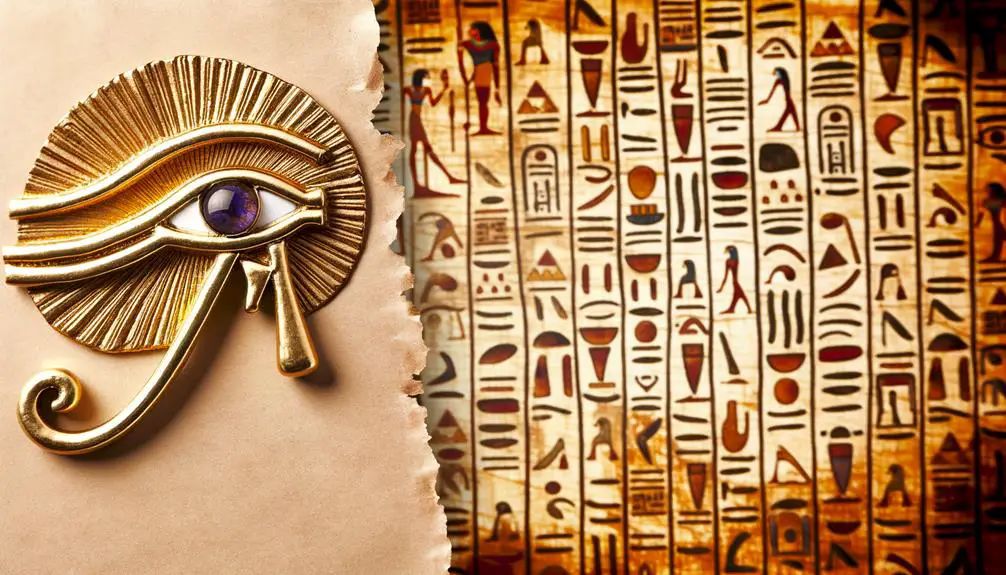
Key Takeaways
- The Eye of Ra symbolizes protection, royal authority, and divine retribution.
- It represents the sun god Ra's vigilant gaze and omnipotence.
- The symbol embodies both benevolent and destructive forces attributed to Ra.
- Amulets featuring the Eye of Ra were believed to ward off evil spirits and negative energies.
- The Eye of Ra is often depicted as a sun disk encircled by a cobra.
Origins of the Eye of Ra
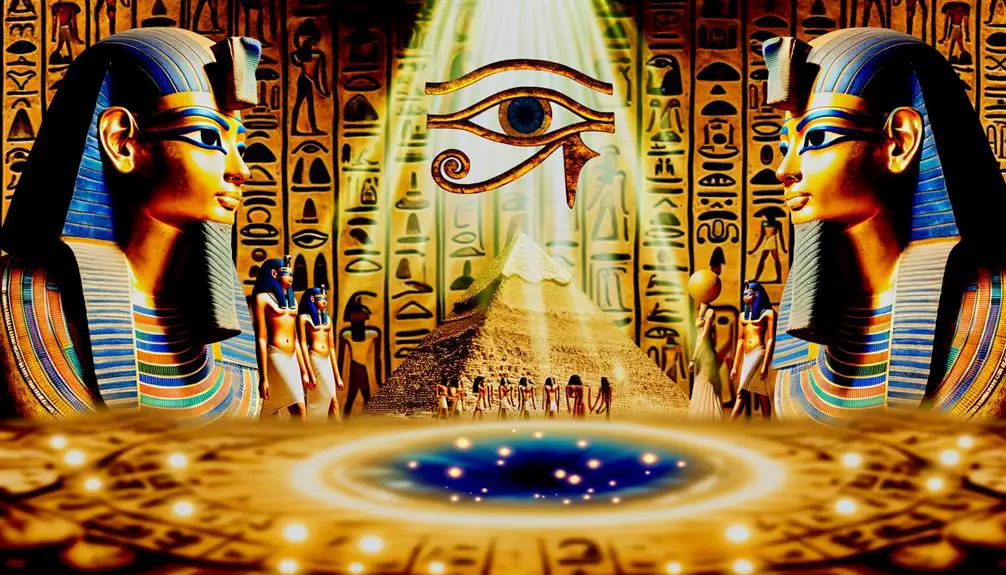
The origins of the Eye of Ra can be traced back to ancient Egyptian mythology, where it was revered as a powerful symbol of protection, royal authority, and divine retribution.
This emblematic figure is often depicted as a sun disk encircled by a cobra, embodying the sun god Ra's vigilant gaze and omnipotence.
Its iconography is rich with layers of meaning, reflecting the duality of creation and destruction.
The Eye of Ra was not merely an artistic motif but an essential element in rituals and statecraft, reinforcing the Pharaoh's divine mandate to rule.
Its presence in amulets and temple carvings underscores its role in safeguarding both the living and the dead, ensuring cosmic order and justice.
Mythological Background
The Eye of Ra, deeply rooted in Egyptian mythology, is intrinsically linked to the solar deity Ra, who was revered as the god of the sun and creation.
This symbol not only embodies Ra's all-seeing prowess and protective nature but also serves as a powerful emblem of divine authority and cosmic order.
Through various symbolic representations, the Eye of Ra encapsulates both the benevolent and destructive forces attributed to the sun god within ancient Egyptian belief systems.
Origins in Egyptian Mythology
Rooted deeply in the ancient pantheon, the Eye of Ra symbolizes protection, royal authority, and divine power within Egyptian mythology. Originating from the worship of Ra, the sun god, this emblem served as a potent amulet believed to ward off evil and secure the sovereign's dominion.
Mythologically, the Eye represents a fierce, protective force, often depicted as an extension of Ra's will. This concept was integral to the Egyptians' understanding of cosmic order and the pharaoh's divine right to rule.
The Eye's association with other deities, such as Hathor and Sekhmet, further underscores its multifaceted role in mythic narratives, emphasizing its significance in maintaining balance and justice within the universe.
Ra and Solar Deity
As one of the most venerated deities in ancient Egyptian religion, Ra epitomized the sun's life-giving and destructive powers, embodying the duality of creation and destruction in his daily journey across the sky. Ra was often depicted steering his solar barque, illuminating the world by day and battling the forces of chaos by night.
Integral to Egyptian cosmology, Ra was associated with:
- Creation Myths: Ra's emergence from the primordial waters symbolized the birth of order from chaos.
- Kingship: Pharaohs were considered the 'Sons of Ra,' legitimizing their divine rule.
- Afterlife Beliefs: Ra's nightly voyage through the underworld ensured the sun's rebirth.
This complex deity encapsulated the cyclical nature of existence, essential to understanding ancient Egyptian spirituality.
Symbolic Representations
Expanding upon Ra's profound significance, the Eye of Ra emerges as a potent symbol encapsulating both his protective and destructive qualities within ancient Egyptian mythology. This emblem, often depicted as a right eye, embodies Ra's power to shield and nurture his followers while simultaneously possessing the ability to unleash fury upon his adversaries.
Mythologically, the Eye of Ra is personified as the goddess Wadjet, who acts as Ra's vigilant defender. This dual nature is vividly illustrated in various narratives where the Eye acts as a fierce avenger against chaos and disorder, maintaining Ma'at, or cosmic balance.
Such symbolic representations underscore Ra's omnipotence, reinforcing the deity's central role in the pantheon and emphasizing the intrinsic dualism of protection and vengeance in ancient Egyptian belief systems.
Symbolic Significance
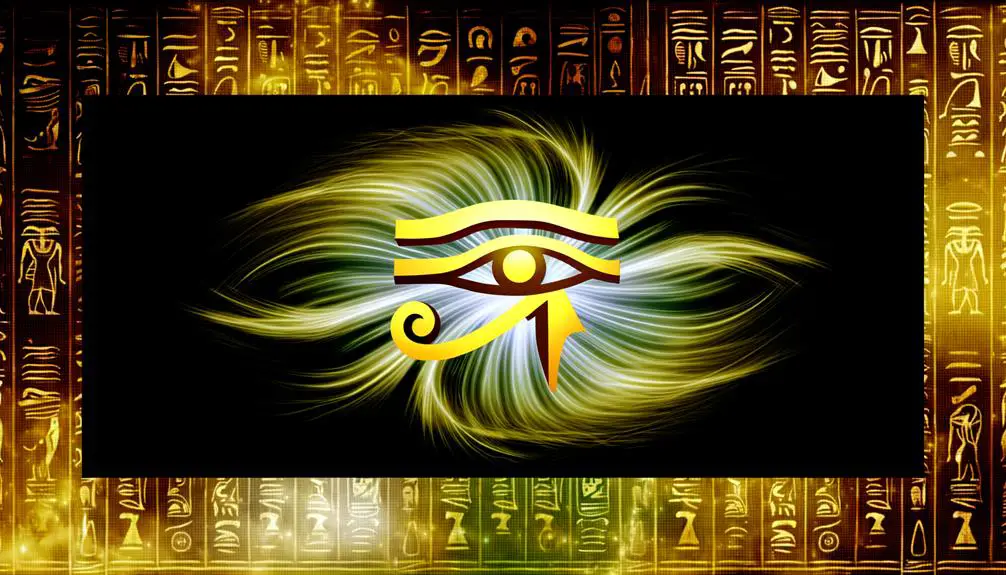
The Eye of Ra holds profound symbolic significance in ancient Egyptian culture. It represents not only the sun but also embodies the concepts of protection, royal authority, and divine power. As an emblem of the sun god Ra, it served as a potent symbol of his omnipresence and ability to oversee and influence the mortal kingdom.
The Eye of Ra was often depicted in various forms of art and iconography, signifying its integral role in ancient Egyptian cosmology and daily life.
- Protection: A guardian against chaos and malevolent forces.
- Royal Authority: A symbol of the Pharaoh's divine right to rule.
- Divine Power: Manifestation of the gods' omnipotence and benevolence.
Understanding these aspects provides a deeper insight into the multifaceted nature of this ancient symbol.
Protective Powers
Renowned for its protective powers, the Eye of Ra was believed to serve as a formidable shield against chaos and malevolent forces, ensuring the stability and order of both the cosmos and the earthly domain.
This ancient symbol, often depicted as a powerful and watchful eye, was thought to embody the vigilant presence of the sun god Ra. It was invoked in rituals and inscribed on amulets to safeguard individuals, communities, and pharaohs.
The Eye's mythological narratives describe it as a fierce entity capable of annihilating enemies and restoring balance. Its protective essence was so revered that it was frequently associated with the preservation of life, health, and prosperity, reflecting its vital role in the Egyptian pantheon and daily life.
Royal Authority
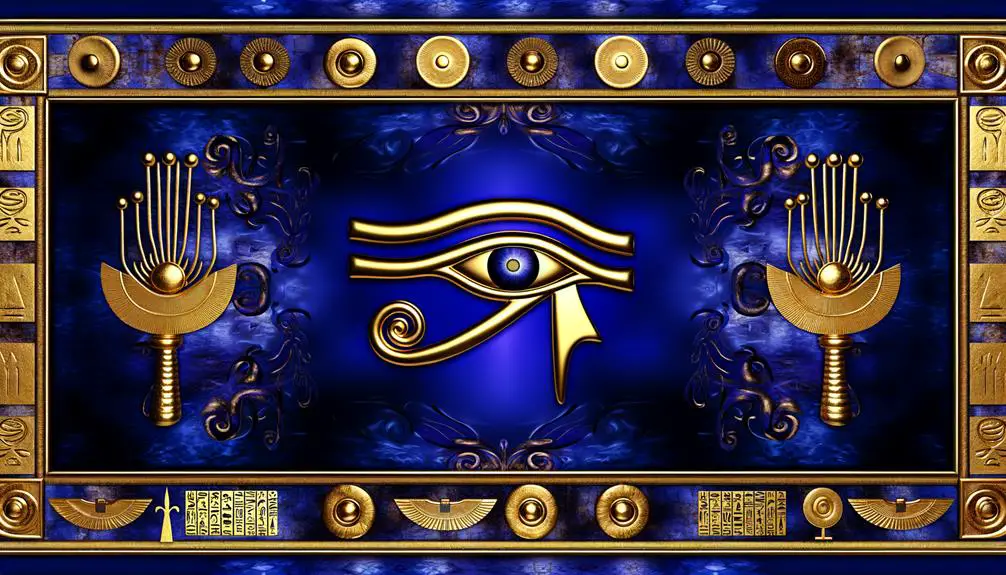
The Eye of Ra, an emblem of immense significance, encapsulates the pharaoh's divine right to rule, signifying celestial endorsement and inherent authority.
This potent symbol of power not only legitimized the ruler's sovereignty but also served as a protective emblem, safeguarding the kingdom against malevolent forces.
Consequently, the Eye of Ra functioned as a multifaceted icon, intertwining notions of divinity, governance, and protection within the ancient Egyptian sociopolitical framework.
Pharaoh's Divine Right
Central to the concept of Pharaoh's divine right, the Eye of Ra symbolized not only the monarch's supreme authority but also his or her sacred mandate to maintain cosmic order and harmony. This potent icon embodied the intertwining of divine and earthly domains, reinforcing the Pharaoh's role as a mediator between gods and humanity.
Theological Legitimacy:
The Eye of Ra was a celestial endorsement of the Pharaoh's divine lineage.
Protective Authority:
It guaranteed the Pharaoh's capacity to safeguard Egypt from chaos and malevolent forces.
Maat's Enforcement:
The symbol underscored the monarch's duty to uphold Maat, the ancient Egyptian principle of truth, balance, and justice.
Symbol of Power
Building upon the theological legitimacy and protective authority granted by the Eye of Ra, this symbol also served as an unequivocal emblem of the Pharaoh's royal power and political supremacy. Its depiction reinforced the notion that the Pharaoh was not just a mortal ruler but a divine sovereign ordained by the gods.
The Eye of Ra epitomized the Pharaoh's ability to maintain order (ma'at) in the cosmos and society, symbolizing his control over both natural and human domains. In royal iconography, the Eye often accompanied images of the Pharaoh, accentuating his supreme status and divine right to govern.
Therefore, the Eye of Ra was instrumental in articulating the Pharaoh's unparalleled authority and his central role in sustaining the divine order.
Protective Emblem
As a potent emblem of protective might, the Eye of Ra was intricately linked to the Pharaoh's divine mandate, serving as a perpetual safeguard against both physical and metaphysical threats. This symbol was not merely decorative but functioned as a powerful amulet, embodying the Pharaoh's ability to vanquish chaos and preserve cosmic order.
The Eye of Ra was believed to offer divine protection, shielding the ruler from malevolent forces. It also possessed magical potency, channeling supernatural abilities to ward off harm. Additionally, it affirmed the Pharaoh's regal authority, solidifying the ruler's role as the earthly representative of divine power.
These attributes underscored the Eye of Ra's integral role in ancient Egyptian statecraft, merging the domains of the divine and the mortal in a cohesive attestation to enduring sovereignty.
Depictions in Art
In ancient Egyptian art, the Eye of Ra is frequently depicted as a powerful symbol of protection, royalty, and divine authority. It is often illustrated with intricate detail and vibrant colors to emphasize its significance. This symbol, typically rendered as a human eye with stylized markings, appears prominently in various artistic mediums such as murals, sculptures, and papyri.
The meticulous attention to its design reflects its revered status within Egyptian cosmology. The eye's placement in temples and tombs signifies its role in warding off malevolent forces and safeguarding the afterlife journey.
Additionally, the Eye of Ra is often juxtaposed with other deities, accentuating its integral role in the pantheon and its association with the sun god's omnipotent and watchful presence.
Amulets and Talismans
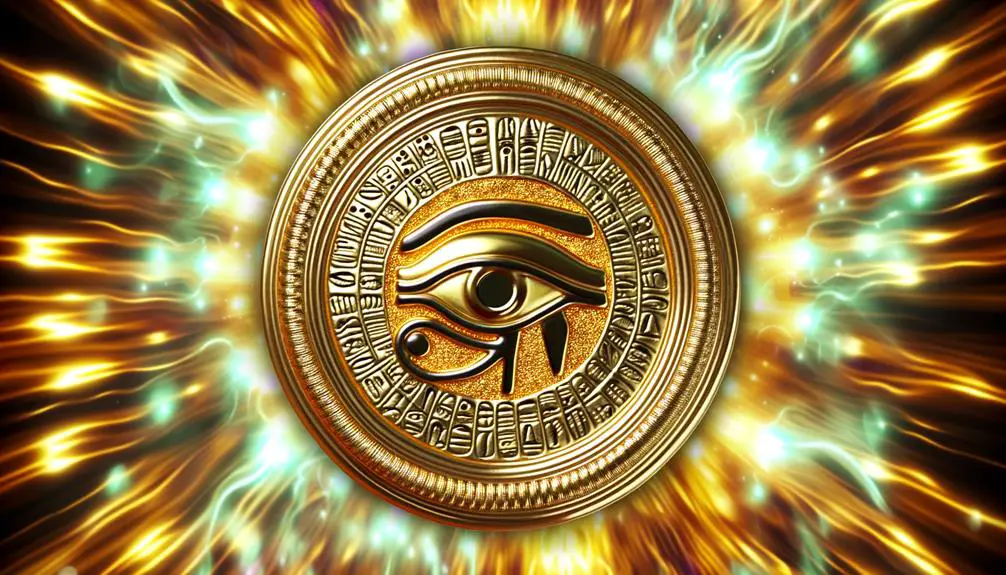
The Eye of Ra, often incorporated into amulets and talismans, was revered for its supposed protective powers, believed to safeguard the wearer from harm and malevolent forces.
Historical records and archaeological findings provide numerous examples of such artifacts, indicating their widespread use across various strata of ancient Egyptian society.
These items, intricately crafted and symbolically potent, serve as proof of the cultural and spiritual significance attributed to the Eye of Ra throughout Egypt's dynastic periods.
Protective Power Beliefs
Throughout ancient Egyptian history, the Eye of Ra has been revered as a potent symbol of protection, often incorporated into amulets and talismans believed to safeguard individuals from harm and malevolent forces. These protective emblems were crafted with meticulous care, reflecting a deep-seated belief in the Eye's divine power.
Key aspects include:
- Spiritual Shielding: Amulets featuring the Eye of Ra were thought to ward off evil spirits and negative energies.
- Health Preservation: It was believed that wearing such talismans could prevent illness and promote overall well-being.
- Symbolic Authority: The Eye also represented the omnipotent gaze of the sun god Ra, reinforcing a sense of divine oversight and cosmic order.
Such beliefs highlight the intricate relationship between symbolism and daily life in ancient Egypt.
Historical Usage Examples
Numerous archaeological discoveries have revealed a variety of amulets and talismans adorned with the Eye of Ra, illustrating its pervasive role in ancient Egyptian protective practices. These artifacts, often crafted from materials such as gold, faience, and semi-precious stones, were believed to harness the divine power of Ra to ward off malevolent forces.
Amulets bearing the Eye of Ra were commonly placed on mummies and within tombs to safeguard the deceased on their journey to the afterlife. Additionally, such talismans were worn by the living for protection against illness and evil spirits.
The widespread use of these objects underscores the profound cultural and religious significance attributed to the Eye of Ra in ancient Egyptian society.
Relationship With the Eye of Horus
In ancient Egyptian mythology, the Eye of Ra and the Eye of Horus are often conflated, yet each symbol possesses distinct meanings and mythological contexts that reflect different aspects of divine power and protection.
The Eye of Ra symbolizes the sun's destructive and protective forces, often associated with the fiery aspect of the goddess Sekhmet.
Conversely, the Eye of Horus represents healing, restoration, and protection, symbolizing the moon and linked to the god Horus.
Understanding these differences enriches the appreciation of ancient Egyptian symbology.
Historical Evolution
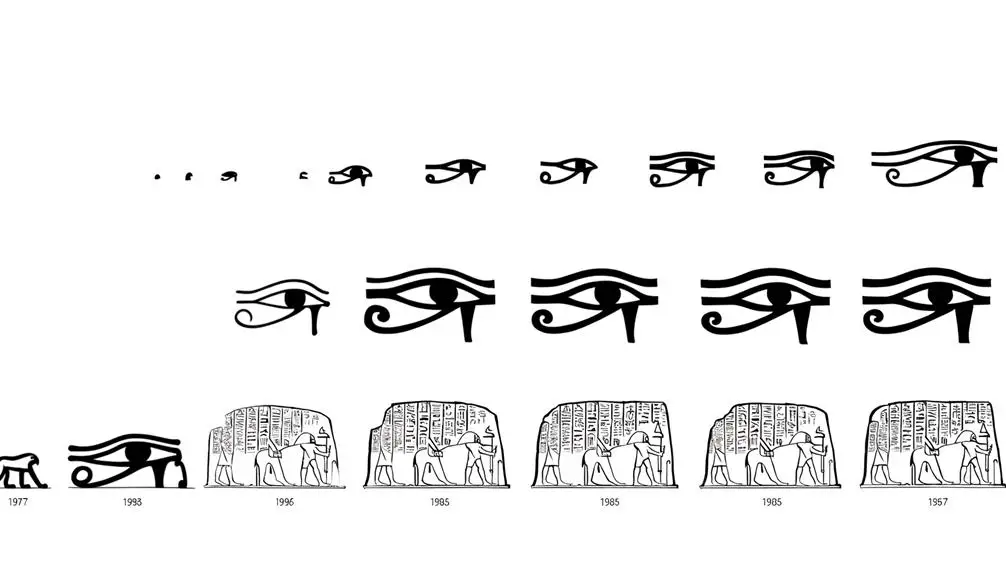
The historical evolution of the Eye of Ra symbol reflects the dynamic interplay between religious beliefs, political power, and cultural exchange in ancient Egyptian society. Initially, the Eye of Ra was primarily associated with the sun god Ra and symbolized his protective and destructive powers.
Over time, its representation evolved, incorporating elements from other deities such as Hathor and Sekhmet, who were seen as extensions of Ra's will. The symbol's prominence grew during periods of centralized power, where it was utilized to legitimize pharaonic authority.
Additionally, as Egypt interacted with neighboring cultures, the Eye of Ra assimilated foreign motifs, enriching its iconography. This way, the symbol's historical trajectory mirrors the complexity and adaptability of Egyptian religious and political landscapes.
Cultural Impact
Building on its historical evolution, the Eye of Ra symbol has permeated various aspects of cultural expression, influencing art, literature, and religious practices within and beyond ancient Egypt.
Its profound impact can be seen through:
- Artistic Representation: Egyptian art frequently depicted the Eye of Ra, symbolizing protection and royal authority.
- Literary References: Ancient texts often invoked the Eye of Ra to emphasize divine retribution and justice.
- Religious Practices: Rituals and amulets incorporated the symbol to invoke the god's power and protection.
The Eye of Ra's enduring presence in these cultural domains underscores its significance. By embodying divine power and cosmic order, the symbol has transcended its original context, leaving an indelible mark on the collective consciousness of various civilizations.
Modern Interpretations
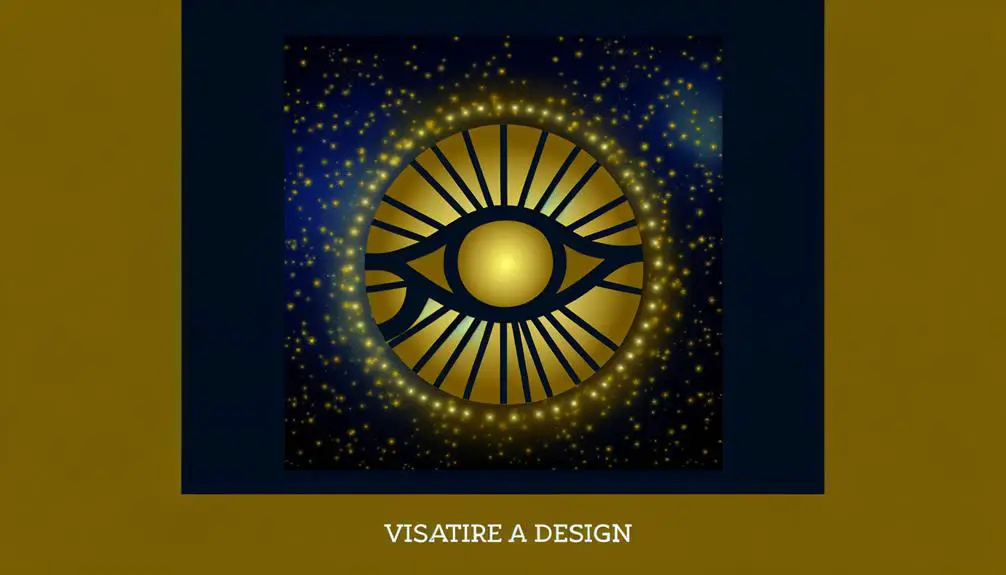
Contemporary perspectives on the Eye of Ra symbol reveal its dynamic reinterpretation in modern spirituality, popular culture, and art.
In modern spirituality, the symbol is often embraced as a protective emblem, signifying vigilance and divine oversight.
Popular culture, particularly in film and literature, frequently utilizes the Eye of Ra as a motif for ancient wisdom and hidden power, reflecting its mythological origins.
In the field of art, the symbol has transcended its historical confines, inspiring contemporary works that blend traditional Egyptian aesthetics with innovative, modern expressions.
This ongoing reinterpretation underscores the Eye of Ra's enduring resonance, highlighting its capacity to adapt and integrate into diverse cultural frameworks while retaining its profound symbolic essence.
Conclusion
The Eye of Ra, an emblem of immense historical depth, carries layers of mythological, symbolic, and cultural significance. Its associations with protection, royal authority, and divine power render it a focal point of ancient Egyptian civilization.
Yet, one cannot help but ponder: as the sands of time shift and modern interpretations evolve, what future meanings might this ancient symbol reveal?
The Eye of Ra, ever-watchful, continues to captivate and inspire through the ages.

